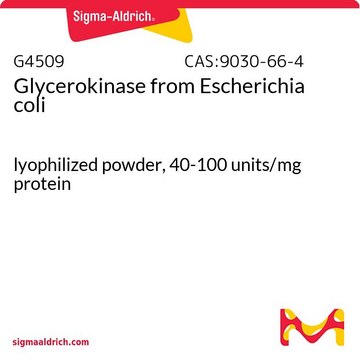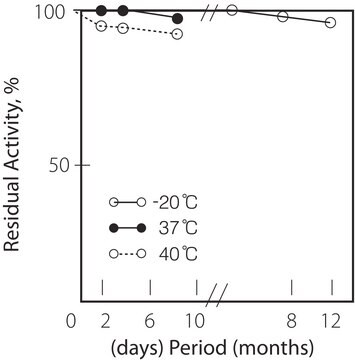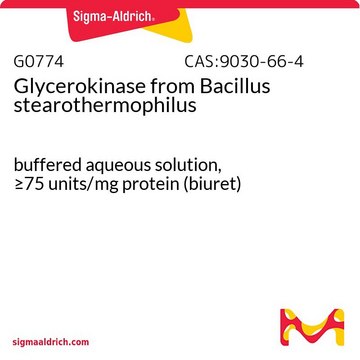G6278
Glycerokinase from Escherichia coli
300-600 units/mL, ammonium sulfate suspension
Synonyme(s) :
ATP:glycerol 3-phosphotransferase, Glycerol Kinase
About This Item
Produits recommandés
Source biologique
Escherichia coli
Niveau de qualité
Forme
ammonium sulfate suspension
Concentration
300-600 units/mL
Température de stockage
2-8°C
Vous recherchez des produits similaires ? Visite Guide de comparaison des produits
Description générale
Glycerol kinase (GK) is a member of the FGGY carbohydrate kinase family (ATP: glycerol 3-phosphotransferase), which is responsible for transferring a phosphate group from ATP to glycerol.
Application
Actions biochimiques/physiologiques
GK participates in the glycerol 3-phosphate shuttle and, in conjunction with glycerol 3-phosphate dehydrogenase, converts glycerol into dihydroxyacetone phosphate. It plays a pivotal role in plasma glycerol withdrawal, glycerol utilization by different tissues, and in maintaining carbohydrate homeostasis. GK is positioned at the nexus of lipid and carbohydrate metabolism and may play a potential role in type 2 diabetes mellitus (T2DM).
Définition de l'unité
Forme physique
Mention d'avertissement
Danger
Mentions de danger
Conseils de prudence
Classification des risques
Resp. Sens. 1
Code de la classe de stockage
11 - Combustible Solids
Classe de danger pour l'eau (WGK)
WGK 3
Point d'éclair (°F)
Not applicable
Point d'éclair (°C)
Not applicable
Équipement de protection individuelle
Eyeshields, Gloves, type N95 (US)
Faites votre choix parmi les versions les plus récentes :
Déjà en possession de ce produit ?
Retrouvez la documentation relative aux produits que vous avez récemment achetés dans la Bibliothèque de documents.
Les clients ont également consulté
Articles
Instructions for working with enzymes supplied as ammonium sulfate suspensions
Notre équipe de scientifiques dispose d'une expérience dans tous les secteurs de la recherche, notamment en sciences de la vie, science des matériaux, synthèse chimique, chromatographie, analyse et dans de nombreux autres domaines..
Contacter notre Service technique







